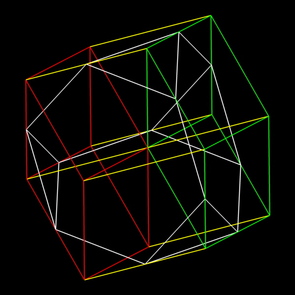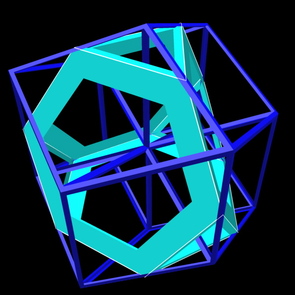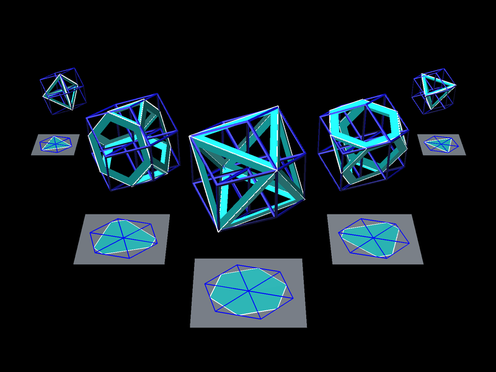The Hypercube: Projections and Slicing
This film treats the convex hull of the sixteen points (±1, ±1, ±1, ±1) in 4-space, first by orthogonal projection then by central projection from 4-space to 3-space. In each case we rotate in the coordinate planes xy, yu, xw, yw, and zw, ending at the original position. We then slice each figure by hyperplanes perpendicular to the vectors (1,0,0,0) then (1,1,0,0) then (1,1,1,0) and finally (1,1,1,1). For a more thorough description of this film, see Banchoff [4].
In these days, programming images of hypercubes is a beginning exercise in introductory courses in computer graphics. Instead of demanding a workstation, it is possible to realize scenes on a laptop computer. Even then the topic had been treated by several researchers, most notablyA. Michael Noll at Bell Laboratories [24]. Our main contribution was a scripted tour of the 4-dimensional cube with three movements, orthographic projections, central projections, and slicing by planes and hyperplanes. After a quarter of a century, this film, now available in video, is still in demand, especially in schools and colleges. For modern interactive versions of the object, see for example the two cube sequences in the interactive art exhibit site "Para Além da Terceira Dimensão'' [17]. The reference [4] is a short description in an article where the illustrations came from Polaroid pictures taken directly off the computer screen!
In these days, programming images of hypercubes is a beginning exercise in introductory courses in computer graphics. Instead of demanding a workstation, it is possible to realize scenes on a laptop computer. Even then the topic had been treated by several researchers, most notablyA. Michael Noll at Bell Laboratories [24]. Our main contribution was a scripted tour of the 4-dimensional cube with three movements, orthographic projections, central projections, and slicing by planes and hyperplanes. After a quarter of a century, this film, now available in video, is still in demand, especially in schools and colleges. For modern interactive versions of the object, see for example the two cube sequences in the interactive art exhibit site "Para Além da Terceira Dimensão'' [17]. The reference [4] is a short description in an article where the illustrations came from Polaroid pictures taken directly off the computer screen!
Iced Cubes
Artist's Comments on Iced Cubes
In this image, we see a sequence of slices of a hypercube that is being cut by a hyperplane perpendicular to the hypercube's long diagonal. The dark blue ribbing is an orthographic view of the hypercube itself from a viewpoint that is parallel to the long diagonal, so the closest and farthest points on the hypercube are both projected to the same point in three-space, namely the center of the figure.
The slices at five different heights are shown in light blue. The symmetry of the view is reflected in the regularity of the slices, which are in the form of regular or semi-regular solids: the tetrahedron, truncated tetrahedron, and octahedron.
Below each hypercube is a plane containing an analogous view of a three-dimensional cube being sliced. The dark blue hexagon made from six equilateral triangles is actually an orthographic view of a cube when viewed from a direction parallel to its long diagonal (see the movies of orthographic projections). of a cube for more details). The light blue figures represent slices of the cube at five different heights.
Our goal is to try to use the slices of the standard cube together with how these correspond to the cube itself (which we understand) to try to use the slicing sequence for the hypercube to generate in our minds an analogous understanding of the hypercube in four dimensions.
The slices at five different heights are shown in light blue. The symmetry of the view is reflected in the regularity of the slices, which are in the form of regular or semi-regular solids: the tetrahedron, truncated tetrahedron, and octahedron.
Below each hypercube is a plane containing an analogous view of a three-dimensional cube being sliced. The dark blue hexagon made from six equilateral triangles is actually an orthographic view of a cube when viewed from a direction parallel to its long diagonal (see the movies of orthographic projections). of a cube for more details). The light blue figures represent slices of the cube at five different heights.
Our goal is to try to use the slices of the standard cube together with how these correspond to the cube itself (which we understand) to try to use the slicing sequence for the hypercube to generate in our minds an analogous understanding of the hypercube in four dimensions.
The Mathematics of Iced Cubes
An important means of understanding a three-dimensional object is to cut it by a series of parallel planes, and look at the two-dimensional slices so produced. For example, in a CAT scan, a doctor obtains a series of two-dimensional images of slices of the human body, and can use these to reconstruct a three-dimensional image of the person being scanned.
We can employ a similar strategy in trying to understand a four-dimensional object. We can slice it by a series of parallel three-dimensional hyperplanes, view the three-dimensional images so produced, and try to reconstruct in hour heads the four-dimensional object from the three-dimensional slices.
To do this, we first look very carefully at how the process lets us understand a simple three-dimensional object such as a cube. Of course, a cube can be sliced in many different ways (see the movies of slices of a cube), but the most interesting views come when we slice it by planes perpendicular to its long diagonal. That is, we start at one corner, and cut off more and more of the cube until we reach the opposite corner.
As we first start to cut off the corner, our slice is an equilateral triangle (one vertex along each edge emanating from the corner, and one edge for each of the three faces meeting at the corner). As we slice further, the triangle grows in size. Eventually, the slice reaches the three corners of the cube that are adjacent to the original corner. As we slice further, the corners of this triangle become truncated (as our slicing plane begins to cut into the remaining three faces of the cube). As we progress further, the triangle becomes more truncated, and at half way through the cube we arrive at a slice that is a perfectly regular hexagon. At this point, all six faces of the cube are sliced in exactly the same way. Moving on from here, the sequence progresses in reverse, with three of the edges of the hexagon getting longer and three shorter (but the opposite ones from before). The short edges disappear as our slice passes three more of the vertices of the cube, leaving us with a triangular slice. This triangle shrinks down to a point as we finally reach the corner of the cube opposite to the one where we started.
This sequence of slices is illustrated in Iced Cubes by the flat images appearing in the planes below the three-dimensional objects. Here we see the largest triangle when the slice passes the first set of three vertices, then the truncated triangle, and in the center the regular hexagon. The sequence is reversed as we move off to the right. The cube itself is represented by the dark blue lines. These form a view of a cube when the viewpoint is directly toward a corner of the cube (see the movies of orthographic views of the cube for more details).
Having understood the slices of a cube, we can try to use that understanding to help imagine the analogous slices of a hypercube formed by hyperplanes perpendicular to its long diagonal. In this case, the slice first hits one corner and cuts it off. Since there are four edges emanating from each corner, the hyperplane cuts each of these edges, producing four vertices in our slice. Four cubical faces of the hypercube meet at the corner that is being cut off, so each is sliced by the hyperplane. From each of these cubes, one corner is being cut off, so the slice forms a triangle in each cube in exactly the same way as we saw above. Thus each cube contributes an equilateral triangle to the slice of the hypercube, and we see that the slice must form a tetrahedron in the slicing hyperplane, a regular solid known to Plato.
As we cut further into the hypercube, this tetrahedron grows larger until it comes to the four corners adjacent to the one being cut off. This situation is shown in Iced Cubes on the far left. Moving past these four vertices, the corners of the tetrahedron become truncated, just as the triangle was truncated in the cube slicing sequence; indeed, at this point, the four cubical faces are being sliced in exactly this way, and as the slice moves further, we arrive at the point where they are sliced as perfect hexagons. The other four cubes of the hypercube are now beginning to be sliced, and each has a corner removed, so the slice is a triangle. Together, the four hexagons and four triangles form a semi-regular figure called the truncated tetrahedron, an Archimedean solid. This can be seen in the second slice shown in the picture.
Moving past this point, the hexagons move toward truncated triangles again, and the other four triangles grow. Eventually, the truncated triangles turn back into triangles as the slice reaches another set of vertices of the hypercube. Now all eight cubes are being sliced in exactly the same way, and each contributes an equilateral triangle to the slice. These eight triangles form a figure known as an octahedron, another Platonic solid. It is a perfectly regular object, half way through the slicing sequence for the hypercube, as shown in the central image in Iced Cubes. This slice has six of the vertices of the hypercube as its corners.
As the hyperplane continues to pass through the hypercube, the sequence reverses itself. Moving past these six vertices, four of the faces of the octahedron begin to form hexagons, but the opposite ones from before. Again, we see the truncated tetrahedron (the fourth slice in the series shown). Eventually the hyperplane passes four more of the hypercube's vertices, and the slice becomes a tetrahedron again (the right-most image in the series). From here, the slice remains a tetrahedron which shrinks down to and disappears at the corner of the hypercube opposite the original one where we started. In the projection of the hypercube we are using, both the starting and ending corners are at the center of the figure; see the movies of slices of the hypercube for a more complete picture of this sequence, and also several other slicing sequences.
© 2000 by Davide P. Cervone. Used with permission.
An important means of understanding a three-dimensional object is to cut it by a series of parallel planes, and look at the two-dimensional slices so produced. For example, in a CAT scan, a doctor obtains a series of two-dimensional images of slices of the human body, and can use these to reconstruct a three-dimensional image of the person being scanned.
We can employ a similar strategy in trying to understand a four-dimensional object. We can slice it by a series of parallel three-dimensional hyperplanes, view the three-dimensional images so produced, and try to reconstruct in hour heads the four-dimensional object from the three-dimensional slices.
To do this, we first look very carefully at how the process lets us understand a simple three-dimensional object such as a cube. Of course, a cube can be sliced in many different ways (see the movies of slices of a cube), but the most interesting views come when we slice it by planes perpendicular to its long diagonal. That is, we start at one corner, and cut off more and more of the cube until we reach the opposite corner.
As we first start to cut off the corner, our slice is an equilateral triangle (one vertex along each edge emanating from the corner, and one edge for each of the three faces meeting at the corner). As we slice further, the triangle grows in size. Eventually, the slice reaches the three corners of the cube that are adjacent to the original corner. As we slice further, the corners of this triangle become truncated (as our slicing plane begins to cut into the remaining three faces of the cube). As we progress further, the triangle becomes more truncated, and at half way through the cube we arrive at a slice that is a perfectly regular hexagon. At this point, all six faces of the cube are sliced in exactly the same way. Moving on from here, the sequence progresses in reverse, with three of the edges of the hexagon getting longer and three shorter (but the opposite ones from before). The short edges disappear as our slice passes three more of the vertices of the cube, leaving us with a triangular slice. This triangle shrinks down to a point as we finally reach the corner of the cube opposite to the one where we started.
This sequence of slices is illustrated in Iced Cubes by the flat images appearing in the planes below the three-dimensional objects. Here we see the largest triangle when the slice passes the first set of three vertices, then the truncated triangle, and in the center the regular hexagon. The sequence is reversed as we move off to the right. The cube itself is represented by the dark blue lines. These form a view of a cube when the viewpoint is directly toward a corner of the cube (see the movies of orthographic views of the cube for more details).
Having understood the slices of a cube, we can try to use that understanding to help imagine the analogous slices of a hypercube formed by hyperplanes perpendicular to its long diagonal. In this case, the slice first hits one corner and cuts it off. Since there are four edges emanating from each corner, the hyperplane cuts each of these edges, producing four vertices in our slice. Four cubical faces of the hypercube meet at the corner that is being cut off, so each is sliced by the hyperplane. From each of these cubes, one corner is being cut off, so the slice forms a triangle in each cube in exactly the same way as we saw above. Thus each cube contributes an equilateral triangle to the slice of the hypercube, and we see that the slice must form a tetrahedron in the slicing hyperplane, a regular solid known to Plato.
As we cut further into the hypercube, this tetrahedron grows larger until it comes to the four corners adjacent to the one being cut off. This situation is shown in Iced Cubes on the far left. Moving past these four vertices, the corners of the tetrahedron become truncated, just as the triangle was truncated in the cube slicing sequence; indeed, at this point, the four cubical faces are being sliced in exactly this way, and as the slice moves further, we arrive at the point where they are sliced as perfect hexagons. The other four cubes of the hypercube are now beginning to be sliced, and each has a corner removed, so the slice is a triangle. Together, the four hexagons and four triangles form a semi-regular figure called the truncated tetrahedron, an Archimedean solid. This can be seen in the second slice shown in the picture.
Moving past this point, the hexagons move toward truncated triangles again, and the other four triangles grow. Eventually, the truncated triangles turn back into triangles as the slice reaches another set of vertices of the hypercube. Now all eight cubes are being sliced in exactly the same way, and each contributes an equilateral triangle to the slice. These eight triangles form a figure known as an octahedron, another Platonic solid. It is a perfectly regular object, half way through the slicing sequence for the hypercube, as shown in the central image in Iced Cubes. This slice has six of the vertices of the hypercube as its corners.
As the hyperplane continues to pass through the hypercube, the sequence reverses itself. Moving past these six vertices, four of the faces of the octahedron begin to form hexagons, but the opposite ones from before. Again, we see the truncated tetrahedron (the fourth slice in the series shown). Eventually the hyperplane passes four more of the hypercube's vertices, and the slice becomes a tetrahedron again (the right-most image in the series). From here, the slice remains a tetrahedron which shrinks down to and disappears at the corner of the hypercube opposite the original one where we started. In the projection of the hypercube we are using, both the starting and ending corners are at the center of the figure; see the movies of slices of the hypercube for a more complete picture of this sequence, and also several other slicing sequences.
© 2000 by Davide P. Cervone. Used with permission.
|
Slicing a Three-Dimensional Cube
|
Slicing a Four-Dimensional Hypercube
|
Orthographic views of the cube and hypercube
|


